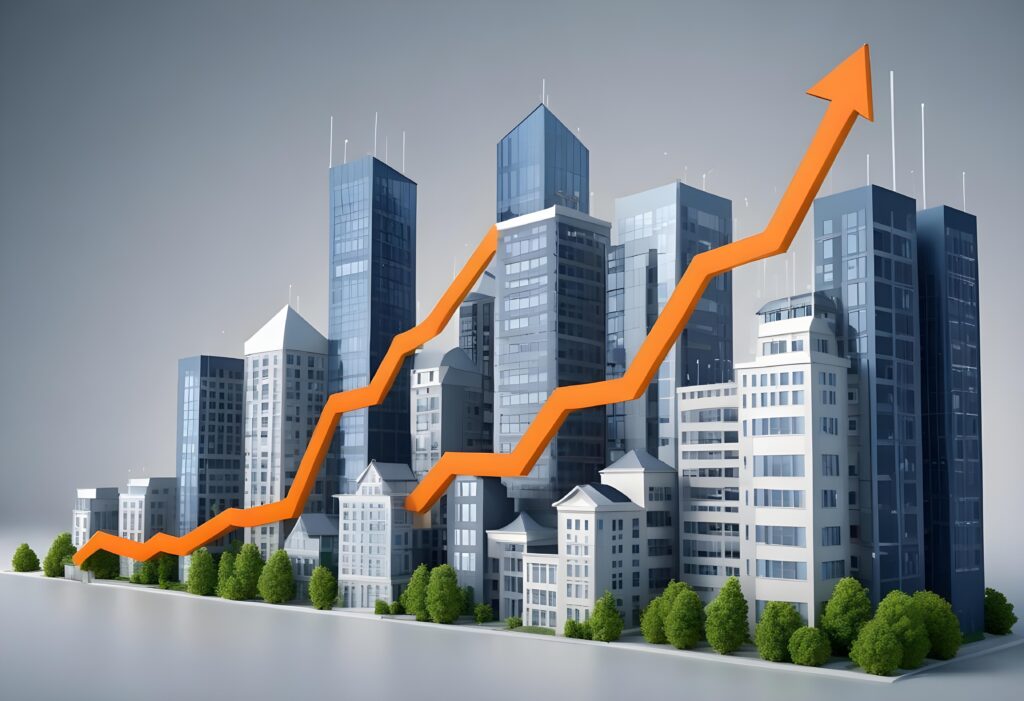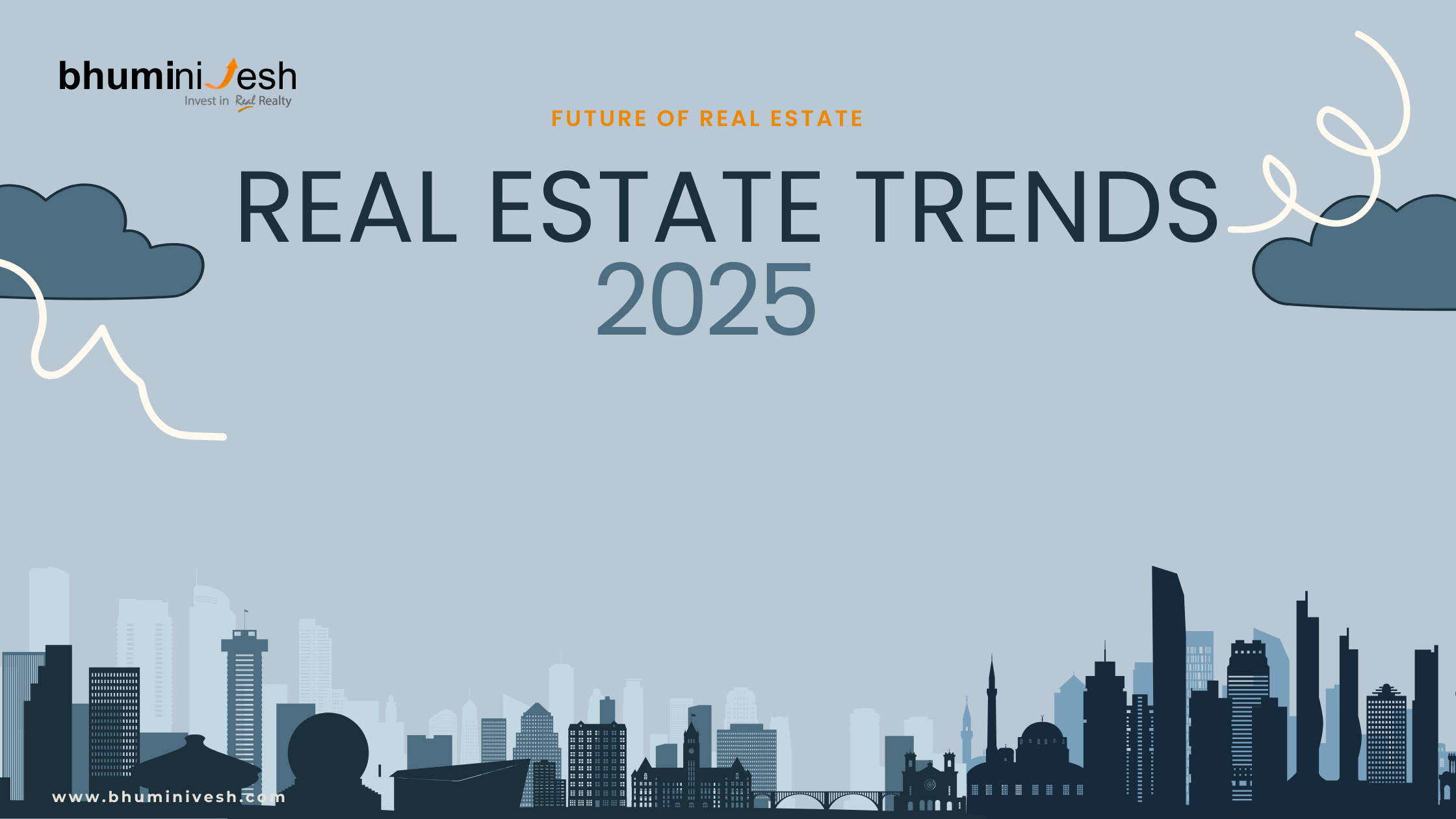
As 2025 draws near, a combination of demographic changes, technology advancements, and changing consumer behavior is causing a significant upheaval in the real estate industry. This essay explores the key themes that will transform the real estate market and provides a prediction based on the most recent information.

Key Trends Transforming Real Estate in 2025
1. An increase in smart and sustainable homes
Smart technology and sustainability are becoming necessities for contemporary living, not just trendy terms.
➡️Green Building Certifications:
It is anticipated that by 2025, around 40% of the world’s commercial real estate stock would consist of green-certified buildings, with India setting the standard in Asia. Growing consumer awareness of climate change and government incentives are driving the quest for sustainable structures.
➡️Technology for Smart Homes:
The incorporation of IoT into residential properties is revolutionary. By 2025, 82% of newly constructed urban residences in key international cities will include smart technology, including automated security, energy-saving gadgets, and voice-activated systems, according to a 2024 Gartner estimate.
➡️Adoption of Renewable Energy:
In sustainable housing, solar energy is becoming more and more important. By 2025, it is anticipated that India’s renewable energy sector would have grown to over 320 GW, with solar installations driving the growth. The Indian government’s objective of achieving net zero emissions by 2070 is in line with this trend.
2. Adaptable Living and Working Environments
The epidemic sparked a long-lasting change in living and working habits, which will become more noticeable in 2025.
➡️Hybrid workspaces with remote work:
Co-working spaces are in high demand as a result of multinational corporations adopting hybrid models. According to Cushman & Wakefield, tier-2 towns like Pune, Jaipur, and Lucknow would become hotspots for the 25% annual growth in flexible office space.
➡️Multipurpose Houses:
Homes are now offices, schools, and gyms in addition to being places to live. According to a Redfin survey from 2023, 65% of homeowners worldwide are upgrading their homes to create multipurpose areas, with a particular emphasis on areas designated for entertainment and home offices.

3. The Revolution in Senior Living
As the world’s population ages, the need for housing is changing, leading to new ideas for senior living.
➡️Dynamics of Aging Populations:
Globally, there will be more than 1.4 billion people 60 and older by 2025, which will increase demand for senior-friendly homes. Retirement villages with recreational and medical amenities are proliferating in India due to the country’s increasingly aging population.
➡️Communities of Active Aging:
The goal of these communities is to give seniors active lifestyles. Fitness centers, hobby classes, and group activities are among the amenities offered to the growing number of seniors seeking independence and participation.
➡️Technology-Assisted Lifestyle:
Voice assistants, fall-detection sensors, and wearable health devices are becoming commonplace in senior living facilities. According to Allied industry Research, this industry is expected to expand at a compound annual growth rate (CAGR) of 18% worldwide.
4. The Rise of E-Commerce and the Development of Real Estate
The relentless expansion of e-commerce is revolutionizing retail and industrial real estate.
➡️Logistics and Storage:
E-commerce behemoths like Amazon and Flipkart are expected to propel the 14% compound annual growth rate of India’s warehousing business. Bengaluru, Mumbai, and Hyderabad are driving the growing demand for Grade A warehouses close to urban hubs.
➡️Transformation of Retail:
By concentrating on multichannel and experiential methods, the retail industry is adjusting to the digital age. Particularly on high streets and urban malls, smaller store forms combined with digital experiences are becoming the standard.

5. The Impact of Technology on Real Estate
PropTech is revolutionizing the marketing, sales, and management of real estate.
➡️Data analytics with artificial intelligence:
Hyper-personalized property searches are now possible thanks to AI-powered systems, which increase lead conversions for agents and developers. By evaluating risks and examining market trends, data analytics is assisting investors in making well-informed decisions.
➡️Blockchain Technology:
Through smart contracts, blockchain is streamlining real estate transactions while maintaining security and transparency. According to Deloitte, blockchain is anticipated to be used in 15% of international real estate transactions by 2025.
➡️Augmented reality and virtual reality:
For distant real estate buyers, virtual tours and AR-based visualization tools are becoming essential. According to Zillow, these technologies have already resulted in a 40% boost in property listing interaction rates.
Prospects for the Future in 2025
Global Real Estate Investments: Due to rising urbanization and infrastructure development, Asia-Pacific is expected to dominate the world in real estate investments, which are expected to reach $2 trillion.
Growth of the Indian Real Estate Market: By 2030, the Indian real estate market is projected to reach a worth of $1 trillion, growing at a CAGR of 13%.
Residential Real Estate: The need for luxury, senior housing, and reasonably priced homes will fuel the expansion of the residential sector. According to a recent Anarock survey, 25% of purchasers value smart house amenities, while 30% give priority to sustainable homes.
Commercial Real Estate: As hybrid work continues, office space will see a comeback. Twenty percent of new office contracts will be co-working spaces by 2025.

New Developments in the Real Estate Industry by 2025
1. City Growth in Tiers Two and Three
Developers and purchasers are gravitating toward tier-2 and tier-3 cities due to the urban congestion in tier-1 cities. Real estate investments in these cities are predicted to increase by 25% year due to better infrastructure and government incentives.
2. Innovations in Affordable Housing
Affordable housing is still a top concern in India due to the growing middle class. Under programs like PMAY (Pradhan Mantri Awas Yojana), developers are investigating government-subsidized projects and modular construction methods.
3. REaaS, or real estate as a service
Real estate services that are subscription-based are becoming more popular. For Gen Z and millennials, REaaS provides customizable options ranging from subscription-based housing to fractional property ownership.
Important Lessons for Stakeholders
1. For developers: To satisfy changing customer expectations, concentrate on smart technologies, adaptable areas, and green certifications.
2. For Investors: High return on investment is possible in tier-2 and tier-3 cities.
3. For purchasers: Give top priority to homes with integrated technology and sustainable features for investments that will last.
Conclusion :
In 2025, the real estate market is expected to be a vibrant, innovative, and expanding environment. The main forces altering the industry are population changes, technology, and sustainability. Developers, investors, and purchasers can take advantage of these trends to succeed in the long run by remaining knowledgeable and flexible.
The sources for the blog data
➡️Green Building & Sustainability: JLL, World Green Building Council.
➡️Smart Homes: Gartner, Statista.
➡️Renewable Energy: IRENA, MNRE (India).
➡️Flexible Living: Cushman & Wakefield, Houzz.
➡️Senior Living: UN DESA, Allied Market Research.
➡️E-commerce & Real Estate: JLL, Deloitte.
➡️PropTech: Deloitte PropTech Index, Zillow.
➡️Tier-2/3 Growth: Knight Frank, Indian Smart Cities Mission.


From Sky Gardens to Smart Rentals: The New Face of Real Estate in 2025



Emerging Real Estate Products Beyond 2BHK & 3BHK: New Concepts Reshaping Urban Living



